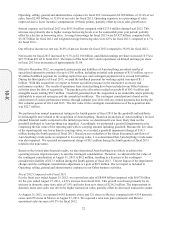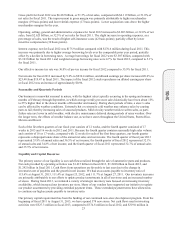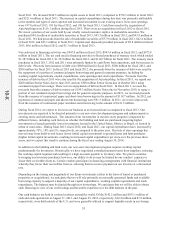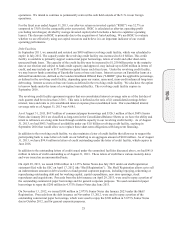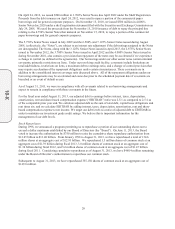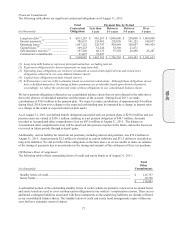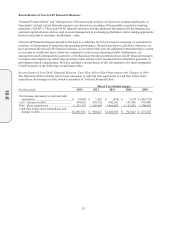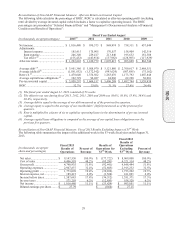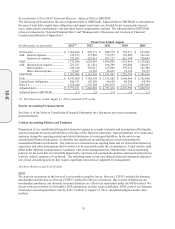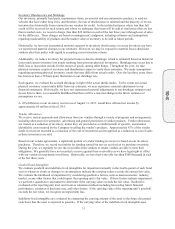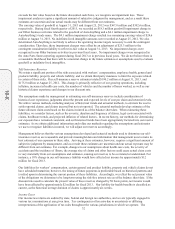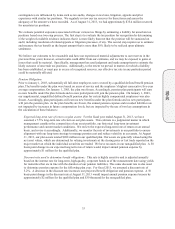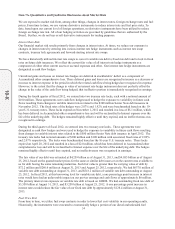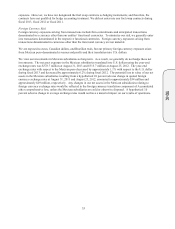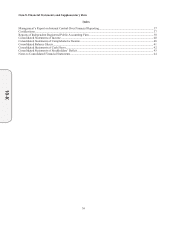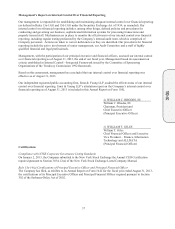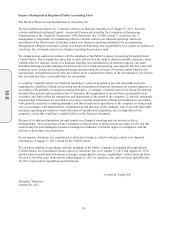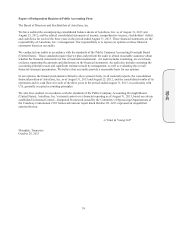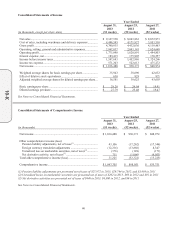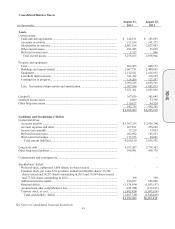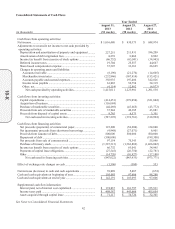AutoZone 2013 Annual Report Download - page 94
Download and view the complete annual report
Please find page 94 of the 2013 AutoZone annual report below. You can navigate through the pages in the report by either clicking on the pages listed below, or by using the keyword search tool below to find specific information within the annual report.
32
exceeds the fair value based on the future discounted cash flows, we recognize an impairment loss. These
impairment analyses require a significant amount of subjective judgment by management, and as a result these
estimates are uncertain and our actual results may be different from our estimates.
The carrying value of goodwill at August 31, 2013 and August 25, 2012 was $367.8 million and $302.6 million,
respectively. During fiscal fourth quarter of 2013, we recorded an $18.3 million goodwill impairment charge in
our Other business activities related to the goodwill of AutoAnything and a $4.1 million impairment charge to
AutoAnything’s trade name. The $4.1 million impairment charge resulted in a remaining carrying value of $24.6
million at August 31, 2013. No indefinite-lived intangible amounts were recorded at August 25, 2012. We also
determined AutoAnything is not likely to achieve the operating income targets necessary to earn the contingent
consideration. Therefore, these impairment charges were offset by an adjustment of $23.3 million to the
contingent consideration liability to reflect its fair value at August 31, 2013. No impairment charges were
recognized in our Other business activities in previous fiscal years. No impairment charges were recognized in
the Auto Parts Stores reporting segment during fiscal 2013 or in previous fiscal years. We do not believe there is
a reasonable likelihood that there will be a material change in the future estimates or assumptions used to evaluate
goodwill or indefinite-lived intangibles.
Self-Insurance Reserves
We retain a significant portion of the risks associated with workers’ compensation, employee health, general and
products liability, property and vehicle liability; and we obtain third party insurance to limit the exposure related
to certain of these risks. Our self-insurance reserve estimates totaled $190.2 million at August 31, 2013, and
$175.8 million at August 25, 2012. This change is primarily reflective of our growing operations, including
inflation, increases in health care costs, the number of vehicles and the number of hours worked, as well as our
historical claims experience and changes in our discount rate.
The assumptions made by management in estimating our self-insurance reserves include consideration of
historical cost experience, judgments about the present and expected levels of cost per claim and retention levels.
We utilize various methods, including analyses of historical trends and actuarial methods, to estimate the cost to
settle reported claims, and claims incurred but not yet reported. The actuarial methods develop estimates of the
future ultimate claim costs based on the claims incurred as of the balance sheet date. When estimating these
liabilities, we consider factors, such as the severity, duration and frequency of claims, legal costs associated with
claims, healthcare trends, and projected inflation of related factors. In recent history, our methods for determining
our exposure have remained consistent, and our historical trends have been appropriately factored into our reserve
estimates. As we obtain additional information and refine our methods regarding the assumptions and estimates
we use to recognize liabilities incurred, we will adjust our reserves accordingly.
Management believes that the various assumptions developed and actuarial methods used to determine our self-
insurance reserves are reasonable and provide meaningful data and information that management uses to make its
best estimate of our exposure to these risks. Arriving at these estimates, however, requires a significant amount of
subjective judgment by management, and as a result these estimates are uncertain and our actual exposure may be
different from our estimates. For example, changes in our assumptions about health care costs, the severity of
accidents and the incidence of illness, the average size of claims and other factors could cause actual claim costs
to vary materially from our assumptions and estimates, causing our reserves to be overstated or understated. For
instance, a 10% change in our self-insurance liability would have affected net income by approximately $12
million for fiscal 2013.
Our liabilities for workers’ compensation, certain general and product liability, property and vehicle claims do not
have scheduled maturities; however, the timing of future payments is predictable based on historical patterns and
is relied upon in determining the current portion of these liabilities. Accordingly, we reflect the net present value
of the obligations we determine to be long-term using the risk-free interest rate as of the balance sheet date. If the
discount rate used to calculate the present value of these reserves changed by 50 basis points, net income would
have been affected by approximately $2 million for fiscal 2013. Our liability for health benefits is classified as
current, as the historical average duration of claims is approximately six weeks.
Income Taxes
Our income tax returns are audited by state, federal and foreign tax authorities, and we are typically engaged in
various tax examinations at any given time. Tax contingencies often arise due to uncertainty or differing
interpretations of the application of tax rules throughout the various jurisdictions in which we operate. The
10-K


